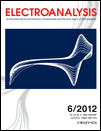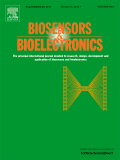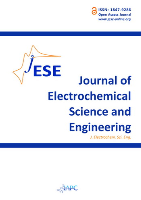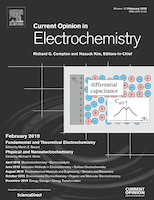
ELECTROANALYSIS
Scope & Guideline
Transforming Knowledge into Electroanalytical Solutions
Introduction
Aims and Scopes
- Electrochemical Sensor Development:
The journal publishes studies on the design and fabrication of novel electrochemical sensors using various materials, including nanomaterials, polymers, and composites, for detecting a wide range of analytes in environmental, biological, and pharmaceutical contexts. - Fundamental Electrochemical Research:
Research articles that explore the fundamental principles of electrochemical reactions, including kinetics, thermodynamics, and mass transport processes, are a core focus. This includes studies on electrode materials and surface modifications. - Application of Electrochemical Techniques:
The journal covers applications of electrochemical methods in various fields such as environmental monitoring, food safety, biomedical diagnostics, and drug analysis, showcasing the versatility of electroanalysis. - Nanomaterials and Hybrid Systems:
There is a strong emphasis on the use of nanomaterials and hybrid systems in sensor design. Studies often explore the integration of nanoparticles, metal-organic frameworks, and conducting polymers to enhance sensor performance. - Sustainable and Green Electroanalytical Methods:
Research contributing to the development of eco-friendly and sustainable electrochemical methods, including the use of biocompatible materials and processes, is increasingly highlighted.
Trending and Emerging
- Wearable and Portable Sensors:
The development of wearable and portable electrochemical sensors for health monitoring and diagnostics is increasingly prominent, driven by the demand for real-time and on-site analysis. - Integration of Machine Learning and AI:
Emerging studies are incorporating machine learning and artificial intelligence to enhance data analysis, sensor design, and predictive modeling in electrochemical applications. - Biocompatible and Green Materials:
There is a growing focus on the use of biocompatible and environmentally friendly materials in sensor fabrication, aligning with global sustainability goals. - Electrochemical Biosensors:
The journal is seeing a rise in research related to electrochemical biosensors, particularly for medical diagnostics and pathogen detection, highlighting the integration of biological elements with electrochemical detection. - Nanotechnology and Advanced Materials:
Research involving advanced nanomaterials, such as 2D materials and metal-organic frameworks, is becoming increasingly common, showcasing their potential to enhance sensor sensitivity and selectivity.
Declining or Waning
- Traditional Electrochemical Techniques:
There is a noticeable decrease in the publication of studies focused solely on traditional electrochemical techniques, such as classical potentiometry and voltammetry, without the incorporation of modern advancements or new materials. - Conventional Electrode Materials:
Research utilizing conventional electrode materials like bulk metal electrodes is becoming less frequent, as the field shifts towards more innovative materials such as nanocomposites and hybrid systems. - Basic Analytical Methods without Novelty:
Papers that present basic analytical methods without significant novelty or improvements are declining, indicating a shift towards more innovative and application-driven research. - Single Analyte Detection:
There is a waning interest in studies focusing solely on the detection of single analytes, with a trend moving towards the development of multi-analyte and simultaneous detection systems. - Low-Impact Environmental Studies:
Research that does not address pressing environmental issues or lacks significant impact in practical applications is being published less frequently, emphasizing the journal's commitment to relevance.
Similar Journals

BIOSENSORS & BIOELECTRONICS
Exploring the Intersection of Technology and BiologyBIOSENSORS & BIOELECTRONICS, published by Elsevier Advanced Technology, is at the forefront of research and innovation in the realms of biomedical engineering, biophysics, and biotechnology. Established in 1990, this esteemed journal has established itself as a premier platform, receiving a prestigious Q1 ranking across multiple categories, including Electrochemistry and Nanoscience, reflecting its critical impact on advancing scientific knowledge and technology. With an impressive range of topics, including the latest trends in biosensor development and bioelectronic application, it serves as an invaluable resource for researchers, professionals, and students alike, facilitating collaborative dialogue and innovative solutions. Though primarily subscription-based, the journal is accessible from its UK headquarters in Oxford, promising rigorous peer-reviewed articles that inform future trends and applications in this dynamic field.

RUSSIAN JOURNAL OF ELECTROCHEMISTRY
Connecting Researchers with Cutting-Edge Electrochemical InsightsThe Russian Journal of Electrochemistry, published by Pleiades Publishing Inc, is a reputable scientific resource that caters to the dynamic field of electrochemistry. Since its inception in 1996, this journal has become a platform for the dissemination of cutting-edge research, exploring both foundational studies and innovative applications within electrochemical science. Despite currently holding a Q4 categorization in its field, the journal is dedicated to enhancing its scholarly impact and visibility, reflecting its commitment to fostering advancements in electrochemical technologies. With its ISSN 1023-1935 and E-ISSN 1608-3342, the journal strives to reach a global audience of researchers, professionals, and students alike. Though the journal is not open access, its contents are crucial for anyone looking to stay at the forefront of electrochemical research and developments. The journal's editorial board includes well-respected experts, ensuring that published articles contribute significantly to the scientific community and pave the way for future innovations in the field.

International Journal of Electrochemistry
Pioneering breakthroughs in energy storage and beyond.The International Journal of Electrochemistry, published by HINDAWI LTD, serves as a premier outlet for cutting-edge research in the expansive field of electrochemistry. With an ISSN of 2090-3529 and an E-ISSN of 2090-3537, this open-access journal has been contributing to the advancement of scientific knowledge since 2011, making its content freely available to researchers, industry professionals, and students around the globe. The journal aims to foster innovation by disseminating high-quality research articles, reviews, and technical notes that encompass a wide range of topics from fundamental electrochemical principles to practical applications in energy storage, sensors, and material development. With a focus on promoting interdisciplinary collaboration and advancing the understanding of electrochemical systems, the International Journal of Electrochemistry is a vital resource for anyone involved in electrochemical research and its applications.

JOURNAL OF SOLID STATE ELECTROCHEMISTRY
Fostering Collaboration in Electrochemical ResearchThe Journal of Solid State Electrochemistry is a leading peer-reviewed journal dedicated to advancing the understanding and application of solid-state electrochemical systems. Published by Springer, this prestigious journal has been a staple in the field since its establishment in 1997, with an impressive range of topics covering Condensed Matter Physics, Electrochemistry, and Materials Science. It holds a notable Q2 category quartile ranking in several disciplines, including Electrical and Electronic Engineering, and boasts significant Scopus rankings—ranked #28 in Electrochemistry, showcasing its credibility and impact in the field. With a mission to disseminate high-quality research and innovative methodologies, the journal aims to foster cross-disciplinary collaboration among researchers, professionals, and students. While not open access, articles published in the Journal of Solid State Electrochemistry are integral for those exploring cutting-edge technologies through theoretical and practical approaches, ultimately enhancing our understanding of energy systems and materials' performance. Located in Germany, the journal continues to thrive internationally, providing a robust platform for scholarly communication.

Journal of Electrochemical Science and Engineering
Connecting Researchers to the Future of Electrochemical Applications.The Journal of Electrochemical Science and Engineering, published by the International Association of Physical Chemists (IAPC), serves as a vital resource for researchers and professionals in the fields of electrochemistry, materials chemistry, and chemical engineering. With an Open Access model since 2011, this journal ensures that groundbreaking research is freely accessible to a global audience, promoting collaboration and knowledge sharing. Situated in Croatia, it showcases cutting-edge developments while focusing on applied aspects related to electrochemical technologies. Notably, the journal holds a commendable Scopus ranking, placing it within the Q3 quartile for multiple categories, including Chemical Engineering (miscellaneous) and Electrochemistry. By fostering innovative research and comprehensive reviews, the Journal of Electrochemical Science and Engineering plays a crucial role in advancing the understanding and application of electrochemical processes, making it an indispensable platform for academics and practitioners alike.

Electrochemical Science Advances
Connecting Ideas, Inspiring Innovations in ElectrochemistryElectrochemical Science Advances, published by WILEY, is an esteemed Open Access journal that has been making significant contributions to the field of electrochemistry since its inception in 2021. With an ISSN of 2698-5977, this journal serves as a vital platform for researchers and practitioners looking to disseminate their findings on a diverse range of topics within the electrochemical sciences and related areas. The journal has achieved commendable rankings in the Scopus database, placing it in the 2nd quartile in Chemistry (miscellaneous) and the 3rd quartile in Electrochemistry, highlighting its relevance and growing influence in the academic community. As it converges from 2021 to 2024, Electrochemical Science Advances aims to foster collaboration and innovation, offering a vital resource for students, professionals, and researchers dedicated to advancing knowledge and technology in electrochemistry. Access to this cutting-edge research is straightforward, allowing for a comprehensive engagement with the latest advances in the field.

Journal of Electroanalytical Chemistry
Unveiling the Future of Electroanalytical ChemistryThe Journal of Electroanalytical Chemistry, published by Elsevier Science SA, stands as a leading platform for the dissemination of cutting-edge research in the field of electroanalytical science. With an impressive impact factor that reflects its esteemed reputation—ranking in the Q1 category for both Analytical Chemistry and Chemical Engineering, alongside a strong presence in Electrochemistry—this journal provides a vital resource for researchers, professionals, and students alike. Covering topics from fundamental electrochemical processes to innovative analytical techniques, the journal aims to foster an in-depth understanding and discussion of contemporary advancements in electroanalytical methodologies. Operating under a model that prioritizes quality and rigor, it facilitates access to high-quality manuscripts and reviews that contribute to the advancement of the field. For over six decades, from 1959 to 2024, it has played an intrinsic role in shaping the landscape of electrochemistry, continually driving forward the frontiers of knowledge and application.

International Journal of Electrochemical Science
Advancing the frontiers of electrochemical research.International Journal of Electrochemical Science is a peer-reviewed journal dedicated to disseminating cutting-edge research in the field of electrochemistry. Published by Elsevier in Serbia, this journal serves as a vital platform for scientists and researchers to explore innovative electrochemical techniques, processes, and applications. With an ISSN of 1452-3981, it has been a respected source of scholarly articles since its inception in 2006 and continues to bridge the gap between theoretical advancements and practical implementations up until 2024. Notably, it holds a Q4 quartile ranking in the field of electrochemistry and ranks 41 out of 60 in the Scopus database, situating it within the 32nd percentile among its peers. The journal champions open academic discourse, contributing significantly to the advancement of knowledge in electrochemical sciences, making it an essential resource for researchers, professionals, and students alike who are striving towards new discoveries and innovations.

Current Opinion in Electrochemistry
Elevating Knowledge in Electrochemical ApplicationsCurrent Opinion in Electrochemistry, published by Elsevier, stands at the forefront of research in the fields of Analytical Chemistry and Electrochemistry. With an impressive Impact Factor reflected in its Q1 quartile rankings for both categories, this journal holds a significant place among its peers, ranking 9th in Analytical Chemistry and 8th in Electrochemistry according to Scopus metrics. Launched in 2017, it has rapidly become a vital platform for the dissemination of cutting-edge insights, reviews, and critical assessments that shape the future directions of electrochemical research and applications. As researchers, professionals, and students engage with its content, they find not only a repository of knowledge but also a source of inspiration for innovative experiments and applications. Readers can explore the wealth of information this journal provides to stay updated with contemporary trends and emerging technologies in electrochemistry. With a commitment to high-quality scholarly content, Current Opinion in Electrochemistry is your essential guide to the evolving landscape of electrochemical science.

JOURNAL OF THE ELECTROCHEMICAL SOCIETY
Advancing Electrochemical Innovation for a Sustainable FutureJOURNAL OF THE ELECTROCHEMICAL SOCIETY, published by the ELECTROCHEMICAL SOCIETY INC, is a leading peer-reviewed academic journal dedicated to advancing the field of electrochemistry and its myriad applications. With an ISSN of 0013-4651 and E-ISSN of 1945-7111, this esteemed journal has been a pivotal platform for research since its inception in 1948, with convergence periods allowing for a rich historical context of study through to 2024. Recognized for its high impact, it holds a noteworthy Q1 ranking in several categories including Condensed Matter Physics and Materials Chemistry, and it is Q2 ranked in both Electrochemistry and Renewable Energy. This journal features a range of articles that encompass both theoretical and experimental advancements, making it a crucial resource for researchers, professionals, and students keen on exploring cutting-edge developments in materials science, energy solutions, and sustainable technologies. Although it is not an open access journal, its rigorous standards ensure that published work significantly contributes to the body of knowledge within its fields, fostering innovative research and collaborative progress.